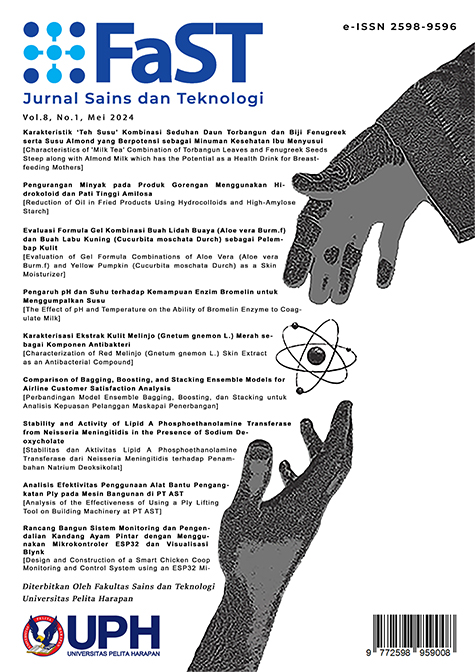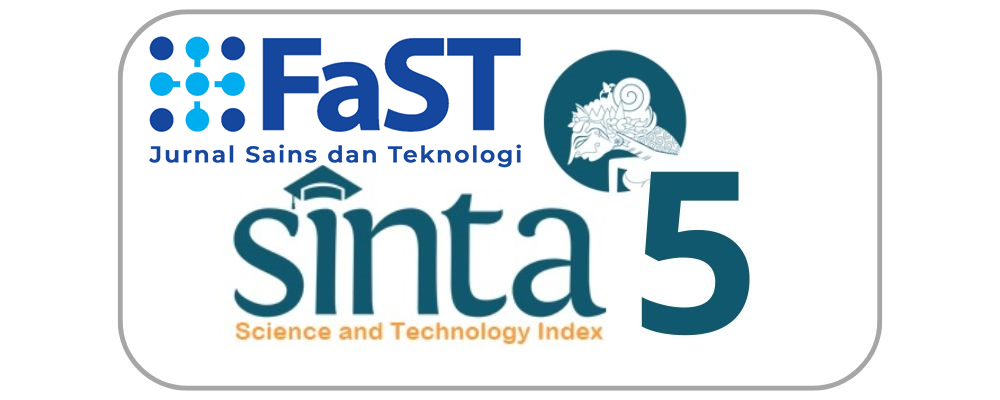STABILITY AND ACTIVITY OF LIPID A PHOSPHOETHANOLAMINE TRANSFERASE FROM NEISSERIA MENINGITIDIS IN THE PRESENCE OF SODIUM DEOXYCHOLATE [STABILITAS DAN AKTIVITAS LIPID A PHOSPHOETHANOLAMINE TRANSFERASE DARI NEISSERIA MENINGITIDIS TERHADAP PENAMBAHAN NATRIUM DEOKSIKOLAT]
DOI:
https://doi.org/10.19166/jstfast.v8i1.8279Keywords:
circular dichroism, lipid A phosphoethanolamine transferase, lipooligosaccharide, n-Dodecyl β-D-maltoside, sodium deoxycholateAbstract
Antibiotics are often used to fight infections caused by pathogenic bacteria. However, inappropriate use of antibiotics has caused many pathogenic bacteria to gain antibiotic resistance. Some resistance mechanisms arise through enzymatic modification of the bacterial membrane. Lipid A phosphoethanolamine transferase (EptA) modifies bacterial membranes through the addition of phosphoethanolamine to the lipid A moiety of lipopolysaccharide (LPS) or lipooligosaccharide (LOS). Inhibition of EptA would therefore restore the antibiotic susceptibility of the bacterium. In order to develop inhibitors against EptA, in vitro studies are required. Biochemical studies of membrane proteins such as EptA, must be carried out in buffers containing detergent to ensure the solubility and stability of the membrane protein. EptA has been found to be most stable in buffers containing the detergent, n-dodecyl β-D-maltoside (DDM). However, due to the fact that LOS is also required for biochemical studies of EptA, the detergent, sodium deoxycholate (DOC) is also required as it prevents the aggregation of LOS. In this study, the stability and activity of EptA in the presence of DOC were investigated using thin layer chromatography (TLC) and circular dichroism (CD) spectroscopy. Additionally, preliminary studies on the interaction of EptA and LOS in vitro was carried out using native agarose gel electrophoresis (NAGE). This study shows that EptA remains active in the presence of ‰¤ 2 mM DOC with the highest activity observed in buffers containing only 1 mM DOC. CD analysis showed that the overall secondary structure of EptA in buffer containing various concentrations of DDM and DOC was maintained. Additionally, through NAGE analysis the interaction between EptA and LOS was successfully observed. Therefore, further in vitro studies incorporating both substrates with supplementation of up to 1 mM DOC could be carried out with the long-term goal of studying inhibitors against EptA.
Bahasa Indonesia Abstract:
Antibiotik sering digunakan untuk melawan infeksi yang disebabkan oleh bakteri patogen. Namun, penggunaan antibiotik yang tidak tepat telah menyebabkan banyak bakteri patogen mendapatkan resistensi antibiotik. Beberapa mekanisme resistensi muncul melalui modifikasi enzimatik dari membran bakteri. Lipid A phosphoethanolamine transferase (EptA) mengubah membran bakteri dengan menambahkan fosfoetanolamina ke bagian lipid A dari lipopolisakarida (LPS) atau lipooligosakarida (LOS). Penghambatan EptA akan mengembalikan kerentanan antibiotik dari bakteri tersebut. Untuk mengembangkan inhibitor terhadap EptA, studi in vitro diperlukan. Studi biokimia protein membran seperti EptA, harus dilakukan dalam larutan penyangga yang mengandung deterjen untuk memastikan kelarutan dan stabilitas protein membran. EptA ditemukan paling stabil dalam larutan penyangga yang mengandung deterjen, n-dodecyl β-D-maltosida (DDM). Namun, karena LOS juga diperlukan untuk studi biokimia EptA, deterjen, sodium deoksikolat (DOC) juga diperlukan karena mencegah agregasi LOS. Dalam penelitian ini, stabilitas dan aktivitas EptA dalam keberadaan DOC diselidiki menggunakan kromatografi lapis tipis (TLC) dan spektroskopi dikroisme sirkular (CD). Selain itu, studi awal tentang interaksi EptA dan LOS in vitro dilakukan menggunakan elektroforesis gel agarosa asli (NAGE). Studi ini menunjukkan bahwa EptA tetap aktif dalam keberadaan ‰¤ 2 mM DOC dengan aktivitas tertinggi diamati dalam larutan penyangga yang hanya mengandung 1 mM DOC. Analisis CD menunjukkan bahwa struktur sekunder keseluruhan EptA dalam larutan penyangga yang mengandung berbagai konsentrasi DDM dan DOC tetap terjaga. Selain itu, melalui analisis NAGE, interaksi antara EptA dan LOS berhasil diamati. Oleh karena itu, studi in vitro lebih lanjut yang memasukkan kedua substrat dengan suplementasi hingga 1 mM DOC bisa dilakukan dengan tujuan jangka panjang untuk mempelajari inhibitor terhadap EptA.
References
Alberts, B., Johnson, A., Lewis, J., Raff, M., Roberts, K., & Walter, P. (2002). Introduction to pathogens. In Molecular biology of the cell. (4th ed.). Garland Science.
Anandan, A. (2018). Structural characterisation of lipid a phosphoethanolamine transferase from Neisseria species [Doctoral Thesis]. The University of Western Australia, Perth, Australia. https://doi.org/10.26182/5bc013e034e26
Anandan, A., & Vrielink, A. (2016). Detergents in membrane protein purification and crystallisation. Advances in Experimental Medicine and Biology, 922, 13-28. https://doi.org/10.1007/978-3-319-35072-1_2
Anandan, A., Evans, G. L., Condic-Jurkic, K., O’Mara, M. L., John, C. M., Phillips, N. J., Jarvis, G. A., Wills, S. S., Stubbs, K. A., Moraes, I., Kahler, C. M., & Vrielink, A. (2017). Structure of a lipid A phosphoethanolamine transferase suggests how conformational changes govern substrate binding. Proceedings of the National Academy of Sciences, 114(9), 2218-2223. https://doi.org/10.1073/pnas.1612927114
Bartley, S. N., & Kahler, C. M. (2014). The glycome of Neisseria spp.: How does this relate to pathogenesis? Caister Academic Press.
Cooley, R. B., Arp, D. J., & Karplus, P. A. (2010). Evolutionary origin of a secondary structure: ϔ-helices as cryptic but widespread insertional variations of α-helices that enhance protein functionality. Journal of Molecular Biology, 404(2), 232-246. https://doi.org/10.1016/j.jmb.2010.09.034
Epand, R. M., Walker, C., Epand, R. F., & Magarvey, N. A. (2016). Molecular mechanisms of membrane targeting antibiotics. Biochimica et Biophysica Acta (BBA) - Biomembranes, 1858(5), 980-987. https://doi.org/10.1016/j.bbamem.2015.10.018
Falagas, M. E., Kasiakou, S. K., & Saravolatz, L. D. (2005). Colistin: The revival of polymyxins for the management of multidrug-resistant gram-negative bacterial infections. Clinical Infectious Diseases, 40(9), 1333-1341. https://doi.org/10.1086/429323
Hardy, E., Rodriguez, C., & Toledo, L. E. T. (2016). Lipopolysaccharide (LPS) and protein-LPS complexes: Detection and characterization by gel electrophoresis, mass spectrometry and bioassays. Biology and Medicine, 08(03). https://doi.org/10.4172/0974-8369.1000277
Inoue, H., Nojima, H., & Okayama, H. (1990). High efficiency transformation of Escherichia coli with plasmids. Gene, 96(1), 23-28. https://doi.org/10.1016/0378-1119(90)90336-p
Islam, M. S., Aryasomayajula, A., & Selvaganapathy, P. (2017). A review on macroscale and microscale cell lysis methods. Micromachines, 8(3), 83. https://doi.org/10.3390/mi8030083
Jeffery, C. J. (2016). Expression, solubilization, and purification of bacterial membrane proteins. Current Protocols in Protein Science, 83(1), 1-29. https://doi.org/10.1002/0471140864.ps2915s83
Kabsch, W., & Sander, C. (1983). Dictionary of protein secondary structure: Pattern recognition of hydrogen”bonded and geometrical features. Biopolymers, 22(12), 2577-2637. https://doi.org/10.1002/bip.360221211
Kohanski, M. A., Dwyer, D. J., & Collins, J. J. (2010). How antibiotics kill bacteria: From targets to networks. Nature Reviews Microbiology, 8(6), 423-435. https://doi.org/10.1038/nrmicro2333
Komuro, T., & Galanos, C. (1988). Analysis of salmonella lipopolysaccharides by sodium deoxycholate””polyacrylamide gel electrophoresis. Journal of Chromatography A, 450(3), 381-387. https://doi.org/10.1016/s0021-9673(01)83593-7
Lewis, L. A., Choudhury, B., Balthazar, J. T., Martin, L. E., Ram, S., Rice, P. A., Stephens, D. S., Carlson, R., & Shafer, W. M. (2009). Phosphoethanolamine substitution of lipid A and resistance of Neisseria gonorrhoeae to cationic antimicrobial peptides and complement-mediated killing by normal human serum. Infection and Immunity, 77(3), 1112-1120. https://doi.org/10.1128/iai.01280-08
Micsonai, A., Wien, F., Kernya, L., Lee, Y.-H., Goto, Y., Réfrégiers, M., & Kardos, J. (2015). Accurate secondary structure prediction and fold recognition for circular dichroism spectroscopy. Proceedings of the National Academy of Sciences, 112(24). https://doi.org/10.1073/pnas.1500851112
Micsonai, A., Moussong, É., Wien, F., Boros, E., Vadászi, H., Murvai, N., Lee, Y., Molnár, T., Réfrégiers, M., Goto, Y., Tantos, A., & Kardos, J. (2022). Bestsel: Webserver for secondary structure and fold prediction for protein CD spectroscopy. Nucleic Acids Research, 50(W1), W90-W98. https://doi.org/10.1093/nar/gkac345
Miles, A. J., Janes, R. W., & Wallace, B. A. (2021). Tools and methods for circular dichroism spectroscopy of proteins: A tutorial review. Chemical Society Reviews, 50(15), 8400-8413. https://doi.org/10.1039/d0cs00558d
Murray, C. J., Ikuta, K. S., Sharara, F., Swetschinski, L., Robles Aguilar, G., Gray, A., ”¦ Naghavi, M. (2022). Global burden of bacterial antimicrobial resistance in 2019: A systematic analysis. The Lancet, 399(10325), 629-655. https://doi.org/10.1016/s0140-6736(21)02724-0
Needham, B. D., & Trent, M. S. (2013). Fortifying the barrier: The impact of lipid A remodeling on bacterial pathogenesis. Nature Reviews Microbiology, 11(7), 467-481. https://doi.org/10.1038/nrmicro3047
O’Neill, J. (2014) Antimicrobial Resistance: Tackling a crisis for the health and wealth of nations. Retrieved 7 May 2024 from https://amr-review.org/sites/default/files/AMR%20Review%20Paper%20-%20Tackling%20a%20crisis%20for%20the%20health%20and%20wealth%20of%20nations_1.pdf
Piek, S., Wang, Z., Ganguly, J., Lakey, A. M., Bartley, S. N., Mowlaboccus, S., Anandan, A., Stubbs, K. A., Vrielink, A., Azadi, P., Carlson, R. W., & Kahler, C. M. (2014). The role of oxidoreductases in determining the function of the neisserial lipid a phosphoethanolamine transferase required for resistance to polymyxin. PLoS ONE, 9(10), e110567. https://doi.org/10.1371/journal.pone.0110567
Preston, A., Mandrell, R. E., Gibson, B. W., & Apicella, M. A. (1996). The lipooligosaccharides of pathogenic gram-negative bacteria. Critical Reviews in Microbiology, 22(3), 139-180. https://doi.org/10.3109/10408419609106458
Provencher, S. W., & Gloeckner, J. (1981). Estimation of globular protein secondary structure from circular dichroism. Biochemistry, 20(1), 33-37. https://doi.org/10.1021/bi00504a006
Sreerama, N., Venyaminov, S. Y. U., & Woody, R. W. (1999). Estimation of the number of α”helical and β”strand segments in proteins using circular dichroism spectroscopy. Protein Science, 8(2), 370-380. https://doi.org/10.1110/ps.8.2.370
Sreerama, N., & Woody, R. W. (2000). Estimation of protein secondary structure from circular dichroism spectra: Comparison of Contin, SELCON, and CDSSTR methods with an expanded reference set. Analytical Biochemistry, 287(2), 252-260. https://doi.org/10.1006/abio.2000.4880
Tzeng, Y.-L., Ambrose, K. D., Zughaier, S., Zhou, X., Miller, Y. K., Shafer, W. M., & Stephens, D. S. (2005). Cationic antimicrobial peptide resistance in Neisseria meningitidis. Journal of Bacteriology, 187(15), 5387-5396. https://doi.org/10.1128/jb.187.15.5387-5396.2005
World Health Organization (WHO). (2018). Global Antimicrobial Resistance Surveillance System (GLASS): The detection and reporting of colistin resistance. Retrieved 7 May 2024 from https://apps.who.int/iris/bitstream/handle/10665/277175/WHO-WSI-AMR-2018.4-eng.pdf
Downloads
Published
Issue
Section
License
“Authors who publish with this journal agree to the following terms:
1) Authors retain copyright and grant the journal right of first publication with the work simultaneously licensed under a Creative Commons Attribution License (CC-BY-SA 4.0) that allows others to share the work with an acknowledgement of the work's authorship and initial publication in this journal.
2) Authors are able to enter into separate, additional contractual arrangements for the non-exclusive distribution of the journal's published version of the work (e.g., post it to an institutional repository or publish it in a book), with an acknowledgement of its initial publication in this journal.
3) Authors are permitted and encouraged to post their work online (e.g., in institutional repositories or on their website). The final published PDF should be used and bibliographic details that credit the publication in this journal should be included.”





